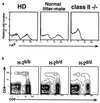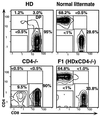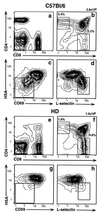HD mice: a novel mouse mutant with a specific defect in the generation of CD4(+) T cells
- PMID: 9653162
- PMCID: PMC20951
- DOI: 10.1073/pnas.95.14.8187
HD mice: a novel mouse mutant with a specific defect in the generation of CD4(+) T cells
Abstract
We have identified a spontaneous mutation in mice, which we term HD for "helper T cell deficient." This mouse is distinguished by the virtual absence of peripheral T cells of the CD4(+)8(-) major histocompatibility complex (MHC) class II-restricted T helper subset due to a specific block in thymic development. The developmental defect is selective for CD4(+)8(-) cells; the maturation of CD4(-)8(+) and gamma delta T cells is normal. The autosomal recessive mutation underlying the HD phenotype is unrelated to MHC class II, since it segregates independently of the MHC class II locus. Moreover, the HD phenotype is not caused by a defect of the CD4 gene. Bone marrow transfer experiments demonstrate that the defect is intrinsic to cells of the hematopoietic lineage, i.e., most likely to developing thymocytes themselves. The frequency of CD4(+)8(low) intermediate cells is markedly increased in HD mice, suggesting that class II-restricted thymocytes are arrested at this stage. This is the first genetic defect of its kind to be described in the mouse and may prove highly informative in understanding the molecular pathways underlying lineage commitment.
Figures






Similar articles
-
Th cells and Th2 responses can develop in the absence of MHC class II-CD4 interactions.J Immunol. 1999 Aug 1;163(3):1162-9. J Immunol. 1999. PMID: 10415010
-
Cross-positive selection of thymocytes expressing a single TCR by multiple major histocompatibility complex molecules of both classes: implications for CD4+ versus CD8+ lineage commitment.J Immunol. 2006 Feb 1;176(3):1628-36. doi: 10.4049/jimmunol.176.3.1628. J Immunol. 2006. PMID: 16424192
-
Constitutive CD8 expression allows inefficient maturation of CD4+ helper T cells in class II major histocompatibility complex mutant mice.J Exp Med. 1994 Jun 1;179(6):1997-2004. doi: 10.1084/jem.179.6.1997. J Exp Med. 1994. PMID: 7515104 Free PMC article.
-
CD4 CTL: living up to the challenge.Semin Immunol. 2013 Nov 15;25(4):273-81. doi: 10.1016/j.smim.2013.10.022. Epub 2013 Nov 15. Semin Immunol. 2013. PMID: 24246226 Free PMC article. Review.
-
The role of CD4 in regulating homeostasis of T helper cells.Immunol Res. 2002;25(2):115-30. doi: 10.1385/IR:25:2:115. Immunol Res. 2002. PMID: 11999166 Review.
Cited by
-
Reversal of the T cell immune system reveals the molecular basis for T cell lineage fate determination in the thymus.Nat Immunol. 2022 May;23(5):731-742. doi: 10.1038/s41590-022-01187-1. Epub 2022 Apr 29. Nat Immunol. 2022. PMID: 35523960 Free PMC article.
-
T cells in health and disease.Signal Transduct Target Ther. 2023 Jun 19;8(1):235. doi: 10.1038/s41392-023-01471-y. Signal Transduct Target Ther. 2023. PMID: 37332039 Free PMC article. Review.
-
The BTB-ZF transcription factors.Cell Cycle. 2012 Sep 15;11(18):3358-69. doi: 10.4161/cc.21277. Epub 2012 Aug 16. Cell Cycle. 2012. PMID: 22894929 Free PMC article. Review.
-
Expanding roles for ThPOK in thymic development.Immunol Rev. 2010 Nov;238(1):182-94. doi: 10.1111/j.1600-065X.2010.00958.x. Immunol Rev. 2010. PMID: 20969593 Free PMC article. Review.
-
Automated discovery of tissue-targeting enhancers and transcription factors from binding motif and gene function data.PLoS Comput Biol. 2014 Jan 30;10(1):e1003449. doi: 10.1371/journal.pcbi.1003449. eCollection 2014 Jan. PLoS Comput Biol. 2014. PMID: 24499934 Free PMC article.
References
-
- Robey E A, Fowlkes B J, Gordon J W, Kioussis D, von Boehmer H, Ramsdell F, Axel R. Cell. 1991;64:99–107. - PubMed
-
- Chan S H, Cosgrove D, Waltzinger C, Benoist C, Mathis D. Cell. 1993;73:225–236. - PubMed
-
- Davis C B, Killeen N, Crooks M E C, Raulet D, Littman D R. Cell. 1993;73:237–247. - PubMed
-
- Suzuki H, Punt J A, Granger L G, Singer A. Immunity. 1995;2:413–425. - PubMed
-
- Matechak E O, Killeen N, Hedrick S M, Fowlkes B J. Immunity. 1996;4:337–347. - PubMed
Publication types
MeSH terms
Substances
Grants and funding
LinkOut - more resources
Full Text Sources
Molecular Biology Databases
Research Materials
Miscellaneous

